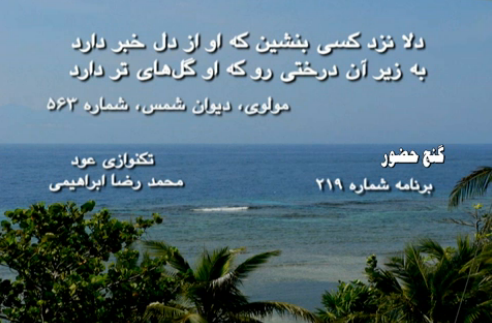

Dastan with Parviz Meshkatian and the Aref Ensemble in Chahaar-Gah (1987).Doud-e-Oud with Parviz Meshkatian and the Tehran Symphony Orchestra in Navaa (1987).Nava – Morakkab Khani with Parviz Meshkatian and the Aref Ensemble in Navaa, Se-gaah and Dashti (1986).Be yaad e Aaref with Mohammad Reza Lotfi in Bayaat e Turk (1986).Bidaad with Parviz Meshkatian and the Aref Ensemble in Homaayoun (1985).Peyvande Mehr (album) with Farhang Sharif (1984).Aastaan e Jaanaan with Parviz Meshkatian and Naaser Farhangfar in Bayaat e Zand (Turk) & Sur (1982).Eshgh Daanad with Mohammad Reza Lotfi in Aboo Ataa (1981).Poetry by Hafez, Saadi and Baba Taher (1977). Part 2 (Dowlat-e Eshq) features Hassan Yusefzamani (Composer), Ahmad Ebadi (Setar), AliAsghar Bahari (Kamancheh).Golbang-e Shajarian, Part 1 (Bot-e Chin) features: Ali Akbar Sheida (Ballads), Fereydun Shahbazian](Composer), Faramarz Payvar (Santur), Hushang Zarif (Tar).Chehre be Chehre with Mohammad Reza Lotfi in Navaa (1977).Raast-Panjgaah concert with Mohammad Reza Lotfi in Raast-panjgaah (1976).used in soundboard beneath the bridge, is contrariwise to the strings, videlicet, the thinner they become, the more low-pitched sounds, and the thicker they become, the more high-pitched sounds they will deliver. However, it should reminded that the function of skin, wood, metal and rubber (caoutchouc), etc.
#DERAKHSHANI ZEKR SKIN#
It can be easily tuned, because modern hydraulic pegs have been utilized.īaarbad’s musical color and sound character slightly differs by changing the skin, and by choosing a thinner or thicker type of skin you can produce a more melodious sound that you desire. Playing the Baarbad is very convenient as it doesn’t have a bowl (belly) as big as Oud (Lute) In addition, the harmonies will be highly lucid and sonorous, regardless of the technique and method employed in playing. Furthermore, this instrument presents its own particular sonority, since the plate under its bridge is made of skin and the back plate can either be made of skin or wood upon the instrumentalist’s taste. And When used as a six-string instrument, different types of Guitar and Banjo string sets will provide it with the best quality. In nine-string mode, a set of strings will be used so that Oud (Lute) players can easily play it. “ Baarbad” is a double-character instrument. A feature that is not offered by violin family. In addition, via changing the skin, bridge or the soundboard beneath the bridge in each of these four instruments, you will be able to modify their musical color according to your taste. The soprano and alto instruments can be played alike “ Kamancheh”. Furthermore, playing the Shahbaang and Shahnavaaz is more convenient and in comparison to cello and contrabass, they weigh less and are smaller in dimensions, therefore, they can be moved with less difficulties in transports and travels. These instruments offer the functionality of violin family with eastern musical color. The front plate is entirely of goat or lamb skin and the body is made of different types of wood such as: walnut, mulberry, ash and maple. The bass instrumentis named “ Shahnavaaz” and the double-bass, “ Shahbaang”. “ ShahrAashoob” family, that is alike violin family, consists of instruments in four different sizes in ascending order the are as follows: soprano, alto, bass and double-bass. It is incumbent upon us to build and give no way to fear and it falls to you to behold the bringer of love through the positive eye, so that we can be a culture-creating nation. It is through time that each instrumentalist has left comments to improve the sound and convenience of tuning the instrument and they have modified it so that the instruments have found their quality of today. Every instrument that was crafted in the old times definitely did not have the shape, composition and quality it holds nowadays. He had “a love” to make a piece of equipment, which could produce a pleasant sound. Our national and folklore musical instruments were not bestowed from heavens to the earth Someone had made them initially, who undoubtedly did not possess such amount of samples and experience in crafting instruments. Otherwise it is doomed to be forgotten in storage and archives. Every instrument, if held in hands of musicians in studios and on stages – so that they create memories for people through their art – after years will enjoy public appeal and achieve the stature of “national musical instrument”.

Instrumentalists are the ones to accredit an instrument.


 0 kommentar(er)
0 kommentar(er)
